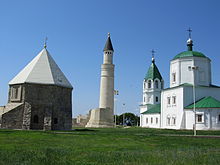Bolghar
| Bolgar Historical and Archaeological Complex | |
|---|---|
| Name as inscribed on the World Heritage List | |
 |
|
| Type | Cultural |
| Criteria | ii, vi |
| Reference | 981 |
| UNESCO region | Europe and North America |
| Coordinates | 54°58′44″N 49°03′23″E / 54.97889°N 49.05639°ECoordinates: 54°58′44″N 49°03′23″E / 54.97889°N 49.05639°E |
| Inscription history | |
| Inscription | 2014 (38th Session) |
Bolghar (Tatar: Cyrillic Болгар, Latin Bulgar, Bolgar, Bolğar, Chuvash: Пăлхар) was intermittently capital of Volga Bulgaria from the 8th to the 15th centuries, along with Bilyar and Nur-Suvar. It was situated on the bank of the Volga River, about 30 km downstream from its confluence with the Kama River and some 130 km from modern Kazan in what is now Spassky District. West of it lies a small modern town, since 1991 known as Bolgar. The UNESCO World Heritage Committee declared ancient Bolghar hill fort as a World Heritage Site in 2014.
The city is supposed to have been the capital of Volga Bulgaria from as early as the 8th century. Regular Russian incursions along the Volga, and internecine fights forced the Volga Bulgar kings to intermittently move their capital to Bilyar. After a destruction of Bilyar during the Mongol invasion, the older capital became a centre of a separate province (or duchy) within the Golden Horde. During the period of Mongol domination Bolgar acquired immense wealth, many imposing buildings, and grew tenfold in size.
The Tokhtamysh–Timur war saw a marked decline in its fortunes. It was sacked by Bulaq-Temir in 1361, endangered by Timur, looted by Russian pirates (ushkuiniki), and destroyed in 1431 by Vasily the Blind of Muscovy. As a Muslim religious center Bolgar persevered until the mid-16th century when the Khanate of Kazan was conquered by the Russian Czar Ivan IV and incorporated into the Russian state.
...
Wikipedia

